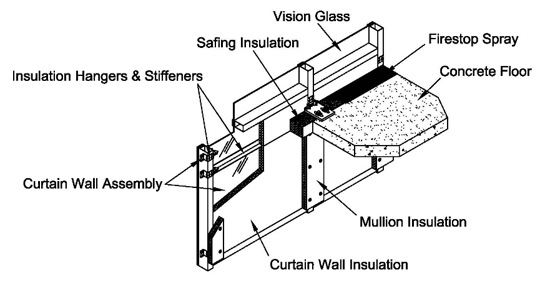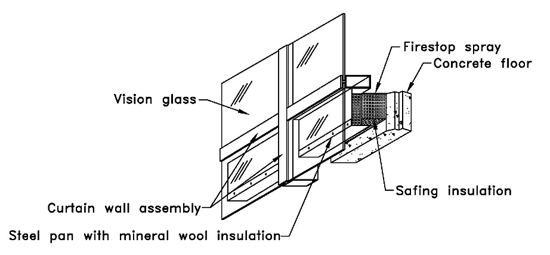IBC Slab Edge Perimeter Fire Containment Requirements: A-Voiding a Misunderstanding
The 2021 International Building Code® was recently published. Section 715 on “Joints and Voids” was refined to make it easier to understand the requirements. Section 715.4 addresses the exterior wall/slab edge intersection.
While the specific requirements are consistent with what appeared in previous versions of the IBC, the section was improved with more concise language to reduce ambiguity. This section, extracted from the 2021 IBC, is reproduced here in its entirety.
| 715.4 Exterior curtain wall/fire-resistance-rated floor intersections. Voids created at the intersection of exterior curtain wall assemblies and fire-resistance-rated floor or floor/ceiling assemblies shall be protected with an approved perimeter fire containment system to prevent the interior spread of fire. Such systems shall provide an F Rating for a time period not less than the fire-resistance rating of the floor or floor/ceiling assembly. 715.4.1 Fire test criteria. Perimeter fire containment systems shall be tested in accordance with the requirements of ASTM E2307. Exception: Voids created at the intersection of the exterior curtain wall assemblies and floor assemblies where the vision glass extends to the finished floor level shall be permitted to be protected with an approved material to prevent the interior spread of fire. Such material shall be securely installed and capable of preventing the passage of flame and hot gases sufficient to ignite cotton waste where subjected to ASTM E119 time-temperature fire conditions under a minimum positive pressure differential of 0.01 inch (0.254 mm) of water column (2.5 Pa) for the time period not less than the fire-resistance rating of the floor assembly. Extracted from 2021 International Building Code® (IBC) |
In 715.4, it is made clear that we are addressing voids created at the intersection between the floor and curtain wall. It now specifies that the protection applied to these void areas and the curtain wall is defined as a “perimeter fire containment system”. This system needs to be capable of providing an F Rating equal to the rating of the floor assembly. This is important because many listed perimeter fire containment systems report both F and T Ratings. The IBC requires the F Rating only, not the T Rating.
Section 715.4.1 identifies the fire test criteria for complying with 715.4. It states that a perimeter fire containment system shall be tested according to ASTM E2307. This is easy as most third-party test labs such as UL test and list perimeter fire containment systems according to ASTM E2307. See Figure 1 for a traditional system tested to ASTM E2307.

Figure 1 Perimeter Fire Containment System (ASTM E2307)
The exception provided is for floor-to-ceiling glass conditions. Sometimes, in these situations, a traditional perimeter fire containment system may not be feasible due to lack of a spandrel area in which to install the system. The IBC provides criteria for such conditions, but it is certainly not easy to determine compliance.
When we break down the exception language, it talks about the use of an approved material. Approved is defined as acceptable to the AHJ. The material must be securely installed. Most accept this to mean that it needs to be secured in place with bent metal plates or a trough. The material must also prevent the passage of flame and hot gases sufficient to ignite cotton waste when tested to ASTM E119 time/temperature fire conditions with positive pressure. It must resist passage of fire and hot gases for a time period equal to the rating of the floor. Historically, this exception has been very difficult to interpret and apply, and thus, most AHJs wrestle with whether to approve or disapprove.
Experience has shown that AHJs seem to prefer tested and listed systems. Recently, systems have been developed that meet ASTM E2307 but also emulate the type of protection system that might be applied to satisfy the exception. Intertek Listing No. STI/BPF 120-03 is one such example. See Figure 2 for floor-to-ceiling glass condition with system supported by metal pan (tested to ASTM E2307).Perhaps with time, these listings will supersede the exception as to apply the exception you basically have to follow the same construction technique and these systems further comply with ASTM E2307. All things being equal, using a tested and listed design (i.e. ASTM E2307 compliant system) instead of an untested and unproven method (i.e. E119 exception) makes everything easier.

Figure 2 Floor-to-Ceiling Glass Condition with Support Pan (ASTM E2307; STI/BPF 120-03)





